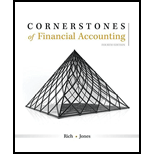
Cornerstones of Financial Accounting
4th Edition
ISBN: 9781337690881
Author: Jay Rich, Jeff Jones
Publisher: Cengage Learning
expand_more
expand_more
format_list_bulleted
Question
Chapter 4, Problem 2MCQ
To determine
Introduction:
Internal
To choose:
The one which is not the three area for which internal control system to provided reasonable assurance.
Expert Solution & Answer
Want to see the full answer?
Check out a sample textbook solution
Students have asked these similar questions
No Ai tool
I need help with this general accounting question using the proper accounting approach.
Solve fast no ai
Chapter 4 Solutions
Cornerstones of Financial Accounting
Ch. 4 - Prob. 1DQCh. 4 - Prob. 2DQCh. 4 - The Sarbanes-Oxley Act increased top managements...Ch. 4 - Prob. 4DQCh. 4 - Prob. 5DQCh. 4 - Prob. 6DQCh. 4 - Prob. 7DQCh. 4 - Prob. 8DQCh. 4 - Prob. 9DQCh. 4 - Prob. 10DQ
Ch. 4 - Prob. 11DQCh. 4 - Prob. 12DQCh. 4 - Prob. 13DQCh. 4 - Prob. 14DQCh. 4 - Prob. 15DQCh. 4 - Prob. 16DQCh. 4 - Prob. 17DQCh. 4 - Prob. 18DQCh. 4 - Prob. 19DQCh. 4 - Prob. 20DQCh. 4 - Prob. 21DQCh. 4 - Prob. 22DQCh. 4 - Prob. 1MCQCh. 4 - Prob. 2MCQCh. 4 - Which of the following is not one of the five...Ch. 4 - Prob. 4MCQCh. 4 - The internal audit function is part of what...Ch. 4 - Prob. 6MCQCh. 4 - Prob. 7MCQCh. 4 - Prob. 8MCQCh. 4 - Which one of the following would not appear on a...Ch. 4 - Prob. 10MCQCh. 4 - Prob. 11MCQCh. 4 - Prob. 12MCQCh. 4 - Prob. 13MCQCh. 4 - Prob. 14MCQCh. 4 - Prob. 15MCQCh. 4 - Prob. 16CECh. 4 - Prob. 17CECh. 4 - Cornerstone Exercise 4-18 Adjusting Entry from...Ch. 4 - Prob. 19CECh. 4 - Prob. 20CECh. 4 - Cornerstone Exercise 4-21 Cash Over and Short On a...Ch. 4 - Cornerstone Exercise 4-22 Cash Over and Short...Ch. 4 - Prob. 23CECh. 4 - Prob. 24CECh. 4 - Prob. 25BECh. 4 - Prob. 26BECh. 4 - Prob. 27BECh. 4 - Prob. 28BECh. 4 - Prob. 29BECh. 4 - Prob. 30BECh. 4 - Prob. 31BECh. 4 - Prob. 32BECh. 4 - Prob. 33BECh. 4 - Prob. 34BECh. 4 - Prob. 35BECh. 4 - Prob. 36BECh. 4 - Prob. 37BECh. 4 - Prob. 38BECh. 4 - Prob. 39ECh. 4 - Prob. 40ECh. 4 - Prob. 41ECh. 4 - Prob. 42ECh. 4 - Miller Enterprises deposits the cash received...Ch. 4 - Prob. 44ECh. 4 - Prob. 45ECh. 4 - Prob. 46ECh. 4 - Prob. 47ECh. 4 - Hawk Enterprises identified the following items on...Ch. 4 - Prob. 49ECh. 4 - Prob. 50ECh. 4 - Prob. 51ECh. 4 - Prob. 52ECh. 4 - Prob. 53ECh. 4 - Exercise 4-54 Operating Cycle and Current...Ch. 4 - Prob. 55APSACh. 4 - Prob. 56APSACh. 4 - Prob. 57APSACh. 4 - Prob. 58APSACh. 4 - Prob. 59APSACh. 4 - Prob. 60APSACh. 4 - Prob. 61APSACh. 4 - Prob. 55BPSBCh. 4 - Prob. 56BPSBCh. 4 - Prob. 57BPSBCh. 4 - Prob. 58BPSBCh. 4 - Prob. 59BPSBCh. 4 - Prob. 60BPSBCh. 4 - Prob. 61BPSBCh. 4 - Prob. 62.1CCh. 4 - Prob. 62.2CCh. 4 - Prob. 62.3CCh. 4 - Prob. 62.4CCh. 4 - Prob. 63.1CCh. 4 - Prob. 63.2CCh. 4 - Prob. 64.1CCh. 4 - Prob. 64.2CCh. 4 - Prob. 65CCh. 4 - Prob. 66.1CCh. 4 - Prob. 66.2CCh. 4 - Prob. 67.1CCh. 4 - Prob. 67.2CCh. 4 - Prob. 68.1CCh. 4 - Prob. 68.2CCh. 4 - Prob. 68.3CCh. 4 - Prob. 68.4CCh. 4 - Prob. 69.1CCh. 4 - Prob. 69.2CCh. 4 - Prob. 69.3CCh. 4 - Prob. 69.4CCh. 4 - Case 4-70 CONTINUING PROBLEM: FRONT ROW...Ch. 4 - Prob. 70.2CCh. 4 - Prob. 70.3CCh. 4 - Prob. 70.4C
Knowledge Booster
Similar questions
- Accurate Answerarrow_forwardPLEASE HELP. the answer is not 257200arrow_forwardDylan Manufacturing had an estimated 90,000 direct labor hours, $360,000 manufacturing overhead, and 30,000 machine hours. The actual results were 91,200 direct labor hours, 32,500 machine hours, and $415,000 manufacturing overhead. Overhead is applied based on machine hours. Calculate the predetermined overhead rate. Need helparrow_forward
- Rivertown Media has reported a total asset turnover of 2.8 times and an ROA of 15% and ROE of 22%. What is the firm's net profit margin?arrow_forwardWhat is the return on equity ?arrow_forwardCypress Ltd.'s contribution margin is $250, after-tax income is $90, and the tax rate is 25%. What are the fixed costs? a. $65 b. $175 c. $130 d. None of the above HELParrow_forward
- General accounting question with helparrow_forwardDylan Manufacturing had an estimated 90,000 direct labor hours, $360,000 manufacturing overhead, and 30,000 machine hours. The actual results were 91,200 direct labor hours, 32,500 machine hours, and $415,000 manufacturing overhead. Overhead is applied based on machine hours. Calculate the predetermined overhead rate. Helparrow_forwardHELParrow_forward
arrow_back_ios
SEE MORE QUESTIONS
arrow_forward_ios
Recommended textbooks for you
 Auditing: A Risk Based-Approach (MindTap Course L...AccountingISBN:9781337619455Author:Karla M Johnstone, Audrey A. Gramling, Larry E. RittenbergPublisher:Cengage Learning
Auditing: A Risk Based-Approach (MindTap Course L...AccountingISBN:9781337619455Author:Karla M Johnstone, Audrey A. Gramling, Larry E. RittenbergPublisher:Cengage Learning Auditing: A Risk Based-Approach to Conducting a Q...AccountingISBN:9781305080577Author:Karla M Johnstone, Audrey A. Gramling, Larry E. RittenbergPublisher:South-Western College Pub
Auditing: A Risk Based-Approach to Conducting a Q...AccountingISBN:9781305080577Author:Karla M Johnstone, Audrey A. Gramling, Larry E. RittenbergPublisher:South-Western College Pub

Auditing: A Risk Based-Approach (MindTap Course L...
Accounting
ISBN:9781337619455
Author:Karla M Johnstone, Audrey A. Gramling, Larry E. Rittenberg
Publisher:Cengage Learning

Auditing: A Risk Based-Approach to Conducting a Q...
Accounting
ISBN:9781305080577
Author:Karla M Johnstone, Audrey A. Gramling, Larry E. Rittenberg
Publisher:South-Western College Pub
